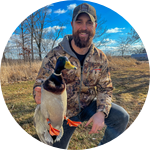About This Project
This study investigates how artificial hen house structures used to increase the nesting success of wild hen mallards may be allowing preferential benefit to hybridized over pure wild mallards. By installing these nesting structures, live trapping, and analyzing genetic and morphological data, the research aims to discern usage patterns between hybrid and wild populations and their implications for conservation, as hen houses are crucial for boosting mallard nesting success and survival.
Ask the Scientists
Join The DiscussionWhat is the context of this research?
This research project investigates if the use of hen house nesting structures by mallards contributes to the survival rates of hybrid populations with domestic breeds across the Great Lakes region of the Midwest. Despite extensive use of hen houses, it's unknown how they affect the increasing hybrid mallard populations, which inherit characteristics less favorable for wild survival. As hybrids become more prevalent, understanding the impact of hen houses, especially in areas with high hybrid presence, is critical. This study aims to evaluate if hen houses exacerbate the survival challenges faced by these mixed populations.
What is the significance of this project?
This research project delves into the pivotal role of hen house nesting structures on the survival rates of increasing hybrid mallards of the Great Lakes region. Historically, the intermingling of game farm-released domestics and wild populations has spurred hybridization, altering the ecological landscape. By assessing the survivability of these hybrids in comparison to their pure wild counterparts, this study aims to unearth the impacts of artificial nesting environments on genetic diversity and ecosystem health. Understanding whether these structures inadvertently favor hybrids could illuminate their influence on hunting practices and conservation efforts, ensuring the preservation of the mallard's genetic integrity and the balance of the regions biodiversity.
What are the goals of the project?
We have designed a study set to commence in Spring 2024 that will involve the deployment and monitoring of hen house nesting structures across selected sites within Ohio, alongside control sites featuring natural nesting environments. This study design will enable us to assess the survival rates, breeding success, and genetic dispersal of mallards utilizing the artificial structures versus those nesting in natural settings. By collecting and analyzing data on nesting success rates, and conducting genetic analyses of both adult mallards and their offspring, we aim to determine if the artificial nesting structures disproportionately benefit hybrid game farm mallards, potentially leading to an increase in the propagation of domestic genes into wild populations.
Budget
The budget for this research is meticulously designed to ensure the success of the study on mallard hen house nesting structures and their impact on hybrid mallard survivability. Field sampling supplies, crucial for collecting genetic and biological samples, include tissue sampling kits and measurement tools, ensuring precise and accurate data collection. Coolers are budgeted to maintain sample integrity during transport, critical for reliable genetic analysis. Laboratory costs encompass the essential processing and analysis of these samples, enabling a deep dive into the genetic makeup and health indicators of the mallard populations studied. Finally, funds allocated for designing and building nesting structures are vital, as these will serve as the primary intervention being tested. This investment not only facilitates the direct examination of nesting preferences among hybrid and wild mallards but also allows for a controlled study of their reproductive success and survivability.
Endorsed by
 Project Timeline
Project Timeline
January to April involves the team designing, building, and installing nesting structures which is the most time-consuming and demanding aspect of the project. April to August includes monitoring nests, brood success, and constructing and installing live capture swim-in traps to obtain birds for sampling and other biometrics crucial to the study. September to December is dedicated to interpreting all samples analyzed, data, and developing reports for utilization in publications, etc.
Mar 10, 2024
Install All Hen House Nesting Structures
Mar 26, 2024
Project Launched
Apr 10, 2024
Observe and Record Observational Nest Data
Aug 31, 2024
Complete the Field Collection Season
Oct 31, 2024
Complete Genetic Sample Analysis and Population Observation Data
Meet the Team
Affiliates
Team Bio
Eric Lance, a wildlife biologist teams with Dr. Gregory Smith, a Kent State terrestrial ecologist studying landscape impacts on wildlife, and Dr. Phil Lavretsky of UTEP, focusing on genomics for species evolution and conservation. Their research aims to enhance management and conservation practices through understanding genetic diversity and adaptation. Dr. Lavretsky is a recognized leader in mallard genetics, advancing waterfowl conservation through genomic insights.
Eric Lance
My name is Eric Lance and I was born and raised in Northeast Ohio, I have always had a profound connection with the natural world that directed my educational and professional paths. I hold a Bachelor's degree in Biology from Kent State University, as well as a Master's degree in Natural Resource Management from Virginia Tech.
I have spent the last fifteen years working across the Midwest, engaging in various conservation projects, environmental planning, and natural resource permitting. I also have a passion for teaching, which I have been doing in the Department of Biological Sciences at Kent State University for the last 7 years.
I am an avid hunter and outdoorsman, and I am deeply involved in waterfowl and upland game bird hunting and conservation. Over the last decade plus, i have committed to my passion for teaching and research, and as a result I am pursuing my PhD in Ecology and Evolutionary Biology from Kent State University.
Philip Lavretsky
My name is Dr. Philip Lavretsky, and I have been running the wildlife genetics lab at the University of Texas at El Paso since 2016. My research program is interdisciplinary where we use data from the field to the gene. By using genetics as the foundation to understand what makes wild species unique, we can better devise conservation initiatives. In short, while my team answers outstanding basic questions within evolutionary biology, we apply the same data towards conservation programs. Although, we work on all wildlife, my team is especially focused on waterfowl conservation. Most recently, partnered with Ducks Unlimited, Inc., we have rolled out the largest citizen-science initiative in the field coined duckDNA, where duck hunters become hunter-scientists!
Additional Information
This project aligns well with the body of work conducted by Dr. Phil Lavretsky. Dr. Lavretsky, known for his extensive worldwide research on the genetics and hybridization of waterfowl, particularly mallards, has established a foundation that this study builds upon. His collaborations with the U.S. Fish and Wildlife Service and Ducks Unlimited to name a few, have focused on understanding the genetic diversity and evolutionary dynamics of mallard populations, addressing conservation challenges, and informing management practices. With his guidance, as well as that of other research experts, this project extends this framework by specifically examining the role of artificial nesting structures in the survival and genetic mixing of hybrid and wild mallards.
By assessing whether these hen house structures contribute to the spread of domestic genes within wild mallard populations, my research provides critical insights into how conservation efforts might inadvertently affect genetic integrity and population dynamics. This knowledge is essential for refining habitat management and conservation strategies, ensuring they support the sustainability of genetically diverse and ecologically balanced mallard populations in the Great Lakes region.
For waterfowl hunters, the implications of this study is significant. Hunters rely on healthy, sustainable mallard populations for recreational hunting, which is an important cultural and economic activity in many regions. Understanding the genetic and ecological impacts of hen house structures can help ensure that conservation practices do not negatively affect mallard populations, thereby supporting robust and genetically diverse populations that are crucial for hunting.
Moreover, by contributing to the broader conservation goals of maintaining healthy waterfowl populations, your research indirectly benefits hunters by ensuring the long-term viability of mallard populations for future generations to enjoy. In essence, this study not only advances scientific understanding but also supports the interests of the hunting community by promoting informed management practices that safeguard the health and diversity of mallard populations.
Project Backers
- 2Backers
- 13%Funded
- $510Total Donations
- $255.00Average Donation



